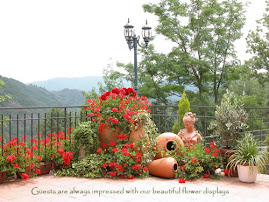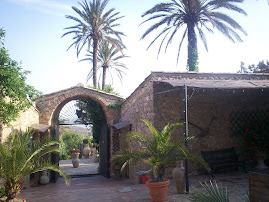
Trip-trek' through Tuscany
This trek is part of the Anello del Rinascimento, an itinerary developed by Gianfranco Bracci for the Florence tourism agency APT. It explores Florence’s immediate surroundings, fascinating for their natural beauty as well as for the art and history they contain. Along the way, the trekker will encounter monasteries, castles, country churches, and ancient walled communities - all without losing sight of Florence’s city centre and Brunelleschi’s magnificent dome.
Take a three-hour walk through history as you cross the same bridge as ancient shepherds and wayfarers took to reach the Pian di Ripoli or even to get as far as the Maremma. They would follow the remains of the ancient via Cassia Adrianea, which led from the Rignano bridge through the pass at Montecucco to the medieval Spedale del Bigallo. Long stretches of historic paved road beckon the trekker on this extraordinary trail.
From the Rignano sull’Arno train station (see box, ‘Getting there’) head for the Pieve di San Leolino, a parish church that dates back to the early eleventh century and seems to have existed before the town. After visiting the church, continue towards the cemetery, where you will see a slightly uphill dirt road leading to an intersection.
There you will find Casa Rignano, a farmhouse that was built around a medieval tower-house. Turn left to climb still further into the woods and you will soon arrive at the fields and olive groves surrounding the scattered farmhouses of the Fattoria di Pagnana, near medieval archaeological site Il Castelluccio.
Cross the next road and after roughly 100 metres, going towards your left, begin to climb right, through the charming little village of Bombone. Follow this until you reach the old road that runs parallel to the more modern one you have just left.
From the small main piazza with its tiny church, bear right until you come to the intersection of‘Il Crocicchio’ and the Strada Provinciale. Cross the intersection and continue straight down the via Vicinale delle Fontanelle path, which dips down slightly to a drainage ditch to rise again towards Casa delle Fontanelle. There is a drinking fountain on your right. Skirt left around the house and continue uphill to a grove of young olive trees.
Cross the grove by following the line of the electricity pylons until the beginning of a firebreak cut under the line itself. After some 200 metres uphill, turn right along the old paved road that plunges into the woods. Be sure to pay close attention as the paved road can be a bit hard to find.
You will soon rejoin the firebreak, then leave it definitively to re-enter the woods right along an uphill, paved mule-track. Once you reach the narrow asphalt road, take a sharp left on the nearby dirt road at a spot called ‘Il Quercione’, named for the large oak tree in the clearing. At the crossroads, turn right and follow the dirt road (which later becomes paved) that leads to Villa di Moriano.
Bypass the asphalt road descending right towards Mitigliano (marked CAI 3), forge straight ahead for 100 metres until you reach the chain slung between two cement posts. On the right, the posts mark a dirt road lined with beautiful cypress trees, which leads to Casignano (AR-CAI 3).
At the first intersection (after barely 200 metres) you will turn right onto a mule-track which rises slightly through the woods, revealing stretches of the ancient paved road. You will pass a second junction with a mule-track ascending right—bypass it and continue downwards through the wood for a short while before turning sharp left and until reaching the dirt road marked CAI 3 once again.
Follow the road right and you will soon arrive at the ruins of the Monastraccio (Casignano)—a medieval monastery that the monks abandoned in the sixteenth century to move to the Bigallo in Bagno a Ripoli. The monastery has in part been restructured as a private house.
Here you will leave the dirt road and the CAI 3 (which would take you to the Terzano pass) and instead turn left along a narrow path. Cross a dirt road that leads to a nearby private house and continues through another oak wood. Narrow at first but then increasingly wider, this ancient road—which is said to be Roman, or at the very least medieval—reveals stretches of very beautiful paving that is partially covered with moss or loose soil. Perhaps some day this gorgeous pavement will be recovered for all to see.
You will soon arrive at the modern villas of Montecucco, which is an important meeting of the paths in Anello del Rinascimento. From here, you can reach San Donato or Bagno a Ripoli or Rosano/Pontassieve, or return by train or bus to your starting point at Rignano sull’Arno, or else to Florence. Take a short deviation (on the right of the pass) to the top of a knoll from which there is an exceptional 360° view of Florence and the Valdarno.
GETTING THERE: Rignano sull’Arno is a half-hour trip on the Florence-Rome train line. Daily trains from Santa Maria Novella station leave approximately every 30 minutes.
ATAF bus 33 will take you back to the train station.
This should inspire you to get out there. It comes from The Florentine. You can read it online on http://www.theflorentine.it

























